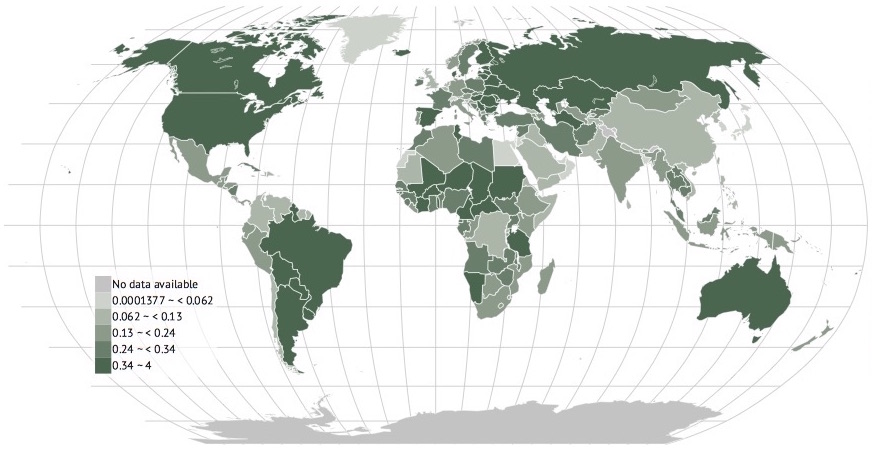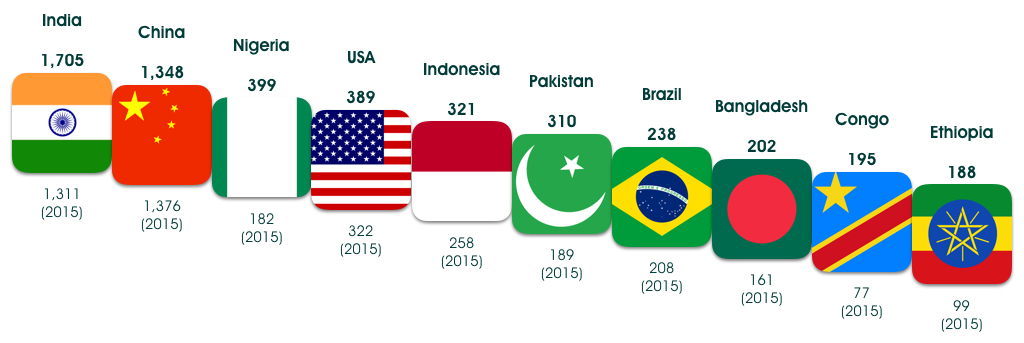Whether the earth is overpopulated should be a simple calculation to make and easy to answer, yet this multifaceted question has perplexed many for generations. Does the Earth have enough resources to supply its population in the foreseeable future?
Based on a population forecast to reach 10 billion by 2050, and assuming that half of the earth’s 150 million square kilometers is habitable, then each person would have access to a plot of land slightly less than 4 acres in size. This would easily be enough for everyone to grow their own food for sustenance, especially considering that in the 50 years to 2010 agricultural productivity tripled and the proportion of land under cultivation increased by only 12 percent. Despite such incredible capacity and wide availability of resources, 2 billion people go to bed hungry every night (almost a third of the world’s population) and 1.2 billion don’t have access to the United Nation’s prescribed 5-13 gallons of fresh water every day. Unfortunately, acknowledging that sufficient food is grown globally to supply everybody with enough calories and nutrition does not prevent regional incidence of food insecurity from occurring.
Cropland Per Capita
(hectares / habitant)
 Source: FAO
Source: FAO
The question needs to be considered in a different way. A discussion about population growth and overpopulation will quickly progress to the ability to feed, house and provide a range of services for everybody on the planet. We need to examine what patterns are developing in different areas of the world, based on the forecast population trends. Here the picture is much less optimistic, and the outlook is deteriorating.
Half of the population growth between now and 2050 will occur in nine countries, five of which are in Africa. Seven of the world’s largest megacities, defined as areas of continuous urban development of over 10 million people, are currently located in Asia. Across emerging economies, where the bulk of population expansion is occurring, migration patterns are resulting in fast expanding cities. This results in geographically concentrated hubs of over-population that catalyze a range of environmental and social problems such as high levels of pollution, deteriorating health and poor nutrition. Meanwhile birth rates are falling and lifespans are increasing across the developed world. The number of people aged 60 and older will more than double in the next 34 years. The number aged 80 and older will triple.
Most Populated Countries by 2050
(million of habitants)
Population drives nearly all of human activity and rapid population growth can exacerbate all kinds of social challenges. Areas of our planet are effectively over-populated and this is leading to problems such as limited healthcare, poverty and pollution. Social unrest and unregulated migration feed off these issues and create their own centers of unrest. Based on the estimates above, it seems incredible to think that the global population will be 40 percent higher at the end of this century than it currently is, and to those who believe that the world is already facing pressure on multiple fronts, the challenges will only become more severe.
Different areas of the globe will each place their own requirements and pressures on global resources driven from overpopulations, be it for land, water, electricity or the supply of food. Housing, transport, energy, employment and basic infrastructure will all combine to supply what the UN describes as one of the most important development challenges of the 21st century. Not only will this represent a political, infrastructural and public health challenge for the world but also a substantial economic opportunity for investors.
We are entering a new age – one that will require a balancing act between the understanding of our growing impact on the environment and the need to invest in the solutions necessary for a sustainable and profitable future. We must drive the alignment the human race and the planet’s ecosystem by embracing and investing in a revolutionary transformation in global agriculture, healthcare, energy systems and construction worldwide.
